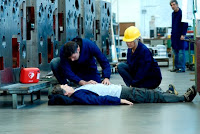Happy Life-Saving Day! (And Your AED Qs Answered)
 This Friday, instead of wishing everyone Happy New Year, I’m tempted to greet those who cross my path with “Happy Life-Saving Day!”
This Friday, instead of wishing everyone Happy New Year, I’m tempted to greet those who cross my path with “Happy Life-Saving Day!”
Sure, it doesn’t have quite the same ring to it, but the point is valid. Why? Because on Friday, January 1, three new Oregon laws go into effect that — at their core — are all about saving lives.
The first is the new cell phone law, which aims to save the lives of Oregon drivers.
The second is the expanded “move-over” law, which aims to save the lives of police officers and other emergency responders.
And the third is the new AED law, which aims to save the lives of employees and anyone who visits a (fairly good sized) place of business. You can read it here.
Because we’ve been helping businesses all over Oregon comply with the third law, I thought I’d clue you in to what I’ve learned that you might not already know.
What does “AED” stand for?
Automated External Defibrillator.
What size is 50,000 sf?
About the size of a city block.
Does “more than 25 visitors per day” include employees?
Yep.
Does the law require AED training?
No, but Oregon’s Good Samaritan Law does. If your business owns an AED, they’ve got to know how to use it. We recommend having 10-15% of employees trained; enough to cover all shifts and when people are out on vacation.
How many AEDs does my building need?
The law states that a 50,000 sf building needs one AED…but they don’t have to stop there. We recommend that — no matter where cardiac arrest happens — an AED should be accessible within a 3 minute brisk round-trip walk. If you’ve got a 15 story building, you probably need more than one AED.
How much does an AED cost?
About $1,500 to $2,500. A reasonable investment to save the life of an employee (who, needless to say, is worth a lot more than that).
Is there any enforcement of this new law?
Let me put it this way. If you don’t have an AED in your building on Friday, no one will come get you. BUT, if someone suffers from cardiac arrest in your building after Friday, you could get hit with a whopping lawsuit. Better safe than sorry, right?
Where should I buy my AED?
Why, from the American Red Cross, of course! As a non-profit, the money you spend on an AED goes right back into funding our disaster relief efforts. So you’re saving lives in Oregon in more ways than one!
Questions? Learn more about the new AED law.